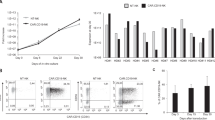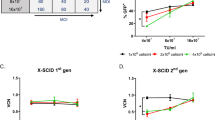Abstract
The transduction efficiencies of immunoselected rhesus macaque (Macaca mulatta) CD34+ cells and colony- forming progenitor cells based on polymerase chain reaction (PCR) analysis were comparable for an amphotropic Moloney murine leukemia virus (MLV) retroviral vector and a retroviral vector derived from the gibbon ape leukemia virus (GaLV) packaging cell line, PG13. On performing autologous transplantation studies using immunoselected CD34+ cells transduced with the GaLV envelope (env) retroviral vector, less than 1% of peripheral blood (PB) contained provirus. This was true whether bone marrow (BM) or cytokine-mobilized PB immunoselected CD34+ cells were reinfused. This level of marking was evident in two animals whose platelet counts never fell below 50000/μl and whose leukocyte counts had recovered by days 8 and 10 after having received 1.7 × 107 or greater of cytokine-mobilized CD34+ PB cells/kg. Reverse transcriptase(RT)-PCR analysis of CD34+ subsets for both the GaLV and amphotropic receptor were performed. The expression of the GaLV receptor was determined to be restricted to CD34+ Thy-1+ cells, and both CD34+ CD38+ and CD34+ CD38dim cells, while the amphotropic receptor was present on all CD34+ cell subsets examined. Our findings suggest that, in rhesus macaques, PG13-derived retroviral vectors may only be able to transduce a subset of CD34+ cells as only CD34+Thy-1+ cells express the GaLV receptor.
This is a preview of subscription content, access via your institution
Access options
Subscribe to this journal
Receive 12 print issues and online access
$259.00 per year
only $21.58 per issue
Buy this article
- Purchase on Springer Link
- Instant access to full article PDF
Prices may be subject to local taxes which are calculated during checkout



Similar content being viewed by others
References
Hughes PFD, Eaves CG, Hogge DE, Humphries RK . High-efficiency gene transfer to human hematopoietic cells maintained in long-term marrow culture Blood 1989 74: 1915–1922
Moritz T, Keller DC, Williams DA . Human cord blood cells as targets for gene transfer: potential use in genetic therapies of severe combined immunodeficiency disease J Exp Med 1993 178: 529–536
Bodine DM et al. Long-term in vivo expression of a murine adenosine deaminase gene in rhesus monkey hematopoietic cells of multiple lineages after retroviral mediated gene transfer into CD34+ bone marrow cells Blood 1993 82: 1975–1980
Hanley ME, Nolta JA, Parkman R, Kohn DB . Umbilical cord blood cell transduction by retroviral vectors: preclinical studies to optimize gene transfer Blood Cells 1994 20: 539–543
Flasshove M et al. Ex vivo expansion and selection of human CD34+ peripheral blood progenitor cells after introduction of a mutated dihydrofolate reductase cDNA via retroviral gene transfer Blood 1995 85: 566–574
Xu LC et al. Growth factors and stromal support generate very efficient retroviral transduction of peripheral blood CD34+ cells from Gaucher patients Blood 1995 86: 141–146
Xu LC et al. Long-term in vivo expression of the human glucocerebrosidase gene in non-human primates after CD34+ hematopoietic cell transduction with cell-free retroviral vector preparations Proc Natl Acad Sci USA 1995 92: 4372–4376
Dunbar CE et al. Retrovirally marked CD34-enriched peripheral blood and bone marrow cells contribute to long-term engraftment after autologous transplantation Blood 1995 85: 3048–3057
Kohn DB et al. Engraftment of gene-modified umbilical cord blood cells in neonates with adenosine deaminase deficiency Nature Med 1995 1: 1017–1023
Miller DG, Adam MA, Miller AD . Gene transfer by retrovirus vectors occurs only in cells that are actively replicating at the time of infection Mol Cell Biol 1990 10: 4239–4242
Luskey BD, Rosenblatt M, Szebo K, Williams DA . Stem cell factor, interleukin-3, and interleukin-6 promote retroviral-mediated gene transfer into murine hematopoietic stem cells Blood 1992 80: 396–402
Berand A, Varas F, Gallego JM, Bueren JA . Ex vivo expansion and selection of retrovirally transduced bone marrow: an efficient methodology for gene-transfer to murine lympho-haemopoietic stem cells Br J Haemotol 1994 87: 6–17
Muench MO et al. Progress in the ex vivo expansion of hematopoietic progenitors Leuk Lymphoma 1994 16: 1–11
Vanbeusechem VW, Bart-Baumeister JA, Hoogerbrugge PM, Valerio D . Influence of interleukin-3, interleukin-6, and stem cell factor on retroviral transduction of rhesus monkey CD34+ hematopoietic progenitor cells measured in vitro and in vivo Gene Therapy 1995 2: 245–255
Bordignon C et al. Gene therapy in peripheral blood lymphocytes and bone marrow for ADA-immunodeficient patients Science 1995 270: 470–475
O’Shaughnessy JA et al. Retroviral mediated gene transfer of the human multidrug resistance gene (MDR-1) into hematopoietic stem cells during autologous transplantation after intensive chemotherapy for metastatic breast cancer Hum Gene Ther 1994 5: 891–911
Dunbar CE et al. Improved retroviral gene transfer into murine and rhesus peripheral blood or bone marrow repopulating cells primed in vivo with stem cell factor and granulocyte colony-stimulating factor Proc Natl Acad Sci USA 1996 93: 11871–11876
Miller AD et al. Construction and properties of retrovirus packaging cells based on the gibbon ape leukemia virus J Virol 1991 65: 2220–2224
Johann SV, Gibbons JJ, O’Hara B . GLVR1, a receptor for gibbon ape leukemia virus, is homologous to a phosphate permease of Neurospora crassa and is expressed at high levels in the brain and thymus J Virol 1992 66: 1635–1640
Miller AD . Cell-surface receptors for retroviruses and implications for gene transfer Proc Natl Acad Sci USA 1996 93: 11407–11413
Kavanaugh MP et al. Cell-surface receptors for gibbon ape leukemia virus and amphotropic murine retrovirus are inducible sodium-dependent phosphate symporters Proc Natl Acad Sci USA 1994 91: 7071–7075
Miller DG, Miller AD . A family of retroviruses that utilize related phosphate transporters for cell entry J Virol 1994 68: 8270–8276
Von Kalle C, Kiem HP, Goehle S, Darovsky B . Increased gene transfer into human hematopoietic progenitor cells by extended in vitro exposure to a pseudotyped retroviral vector Blood 1994 84: 2890–2897
Vandendriessche T et al. Inhibition of clinical human immunodeficiency virus (HIV) type 1 isolates in primary CD4+ T lymphocytes by retroviral vectors expressing anti-HIV genes J Virol 1995 69: 4045–4052
Donahue RE et al. Peripheral blood CD34+ cells differ from bone marrow CD34+ cells in Thy-1 expression and cell cycle status in non-human primates mobilized or not mobilized with granulocyte colony-stimulating factor and/or stem cell factor Blood 1996 87: 1644–1653
Brenner MK et al. Gene marking to determine whether autologous marrow infusion restores long-term haemopoiesis in cancer patients Lancet 1993 342: 1134–1137
Deisseroth AB et al. Genetic marking shows that Ph+ cells present in autologous transplants of chronic myelogenous leukemia (CML) contribute to relapse after autologous bone marrow in CML Blood 1994 83: 3068–3076
Bunnell BA et al. High-efficiency retroviral-mediated gene transfer into human and non-human primate peripheral blood lymphocytes Proc Natl Acad Sci USA 1995 92: 7739–7743
Bunnell BA et al. Efficient in vivo marking of primary CD4+ T lymphocytes in non-human primates using a gibbon ape leukemia virus derived retroviral vector Blood 1997 89: 1987–1995
Kiem HP et al. Gene transfer into marrow repopulating cells: comparisons between amphotropic and gibbon ape leukemia virus pseudotyped retroviral vectors in a competitive repopulation assay in baboons Blood 1997 90: 4638–4645
Bender JG, To LB, Williams S, Schwartzberg LS . Defining a therapeutic dose of stem cells J Hematother 1992 1: 329–341
Mavroudis D et al. CD34+ cell dose predicts survival, post-transplant morbidity, and rate of hematologic recovery after allogeneic marrow transplants for hematologic malignancies Blood 1996 88: 3223–3229
Bender JG et al. Identification and comparison of CD34-positive cells and their subpopulations from normal peripheral blood and bone marrow using multicolor flow cytometry Blood 1991 77: 2591–2596
Craig W, Kay R, Cutler RL, Lansdorp PM . Expression of Thy-1 on human hematopoietic progenitor cells J Exp Med 1993 177: 1331–1342
Terstappen LWMM et al. Sequential generations of hematopoietic colonies derived from single nonlineage-committed CD34+ CD38− progenitor cells Blood 1991 77: 1218–1227
Osawa M, Hanada K, Hamada H, Nakaguchi H . Long-term lymphohematopoietic reconstitution by a single CD34-low/negative hematopoietic stem cell Science 1996 273: 242–245
Orlic D et al. The level of mRNA encoding the amphotropic retrovirus receptor in mouse and human hematopoietic stem cells is low and correlates with the efficiency of retrovirus transduction Proc Natl Acad Sci USA 1996 93: 11097–11102
Donahue RE et al. Transplantation and gene transfer of the human glucocerebrosidase gene into immunoselected primate CD34+ Thy-1+ cells Blood 1996 88: 4166–4172
Miller AD, Buttimore C . Redesign of retrovirus packaging cell lines to avoid recombination leading to helper virus production Mol Cell Biol 1986 6: 2895–2902
Miller AD, Rosman G . Improved retroviral vectors for gene transfer and expression Biotechniques 1989 7: 980–990
Author information
Authors and Affiliations
Rights and permissions
About this article
Cite this article
Bunnell, B., Kluge, K., Lee-Lin, SQ. et al. Transplantation of transduced nonhuman primate CD34+ cells using a gibbon ape leukemia virus vector: restricted expression of the gibbon ape leukemia virus receptor to a subset of CD34+ cells. Gene Ther 6, 48–56 (1999). https://doi.org/10.1038/sj.gt.3300808
Received:
Accepted:
Published:
Issue Date:
DOI: https://doi.org/10.1038/sj.gt.3300808
Keywords
This article is cited by
-
Hematopoietic stem cell gene therapy with drug resistance genes: an update
Cancer Gene Therapy (2005)



